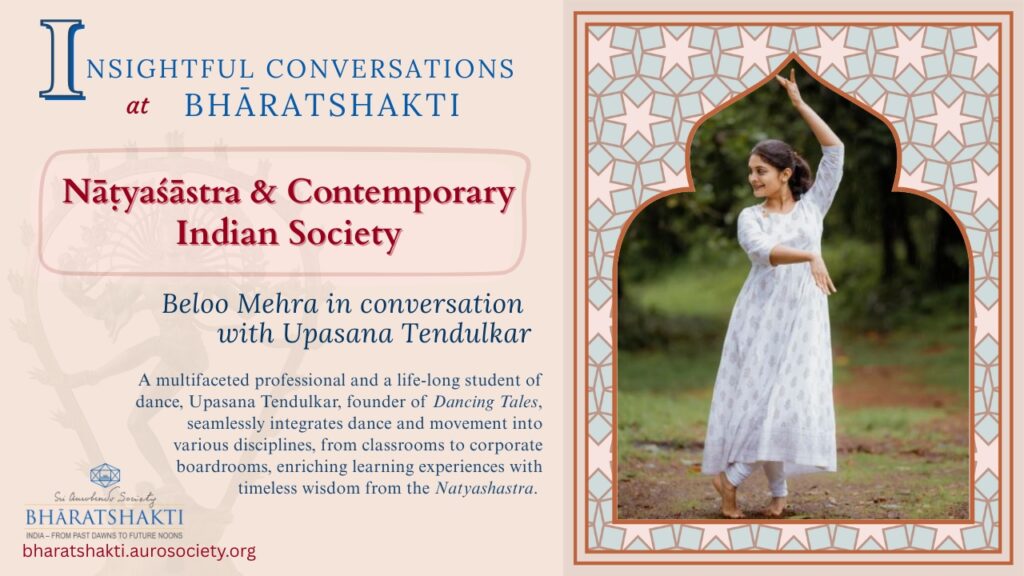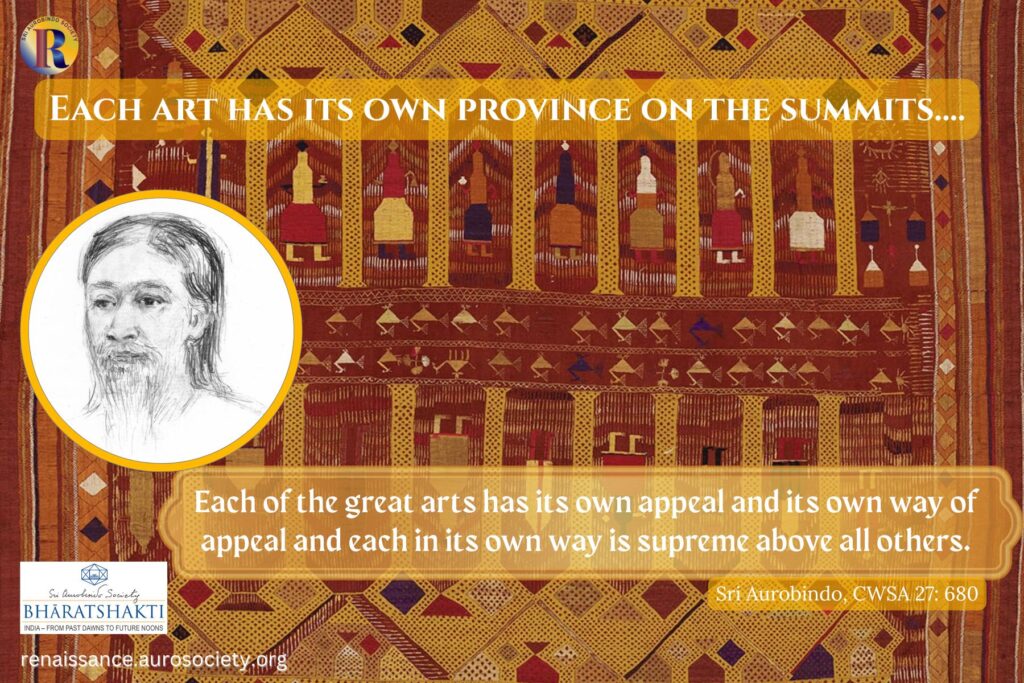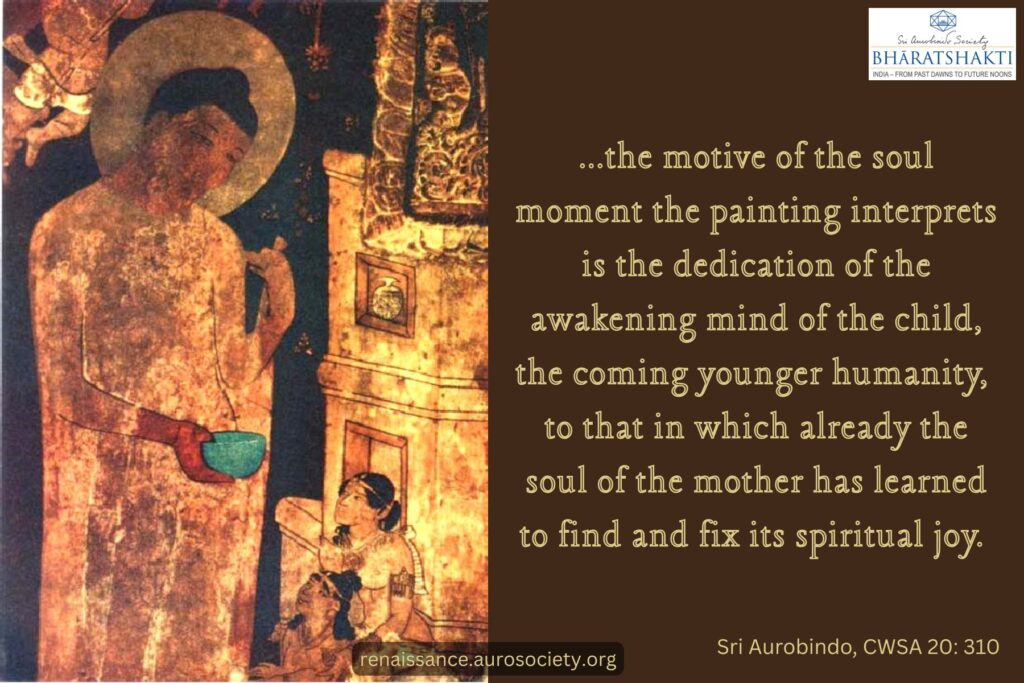Volume V, Issue 10
Author: Nolini Kanta Gupta
Editor’s Note: This masterly essay is excerpted from Collected Works of Nolini Kanta Gupta, Vol. 7, pp. 68-75. It speaks of two key points: what is the purpose of art; and what is the rightful place of spirituality in art. This essay was originally titled ‘Spirituality in Art’. We have taken the liberty of changing the title. And have also made a few minor formatting revisions for this presentation.
We begin with a quote from Sri Aurobindo:
To use the terms of Indian philosophy, most art expresses the play of Prakriti; Buddhistic art in its most characteristic creations expresses the absolute repose of the Purusha; Hindu art tends to combine the Purusha and Prakriti in one image.
~ CWSA, Vol. 1, p. 584

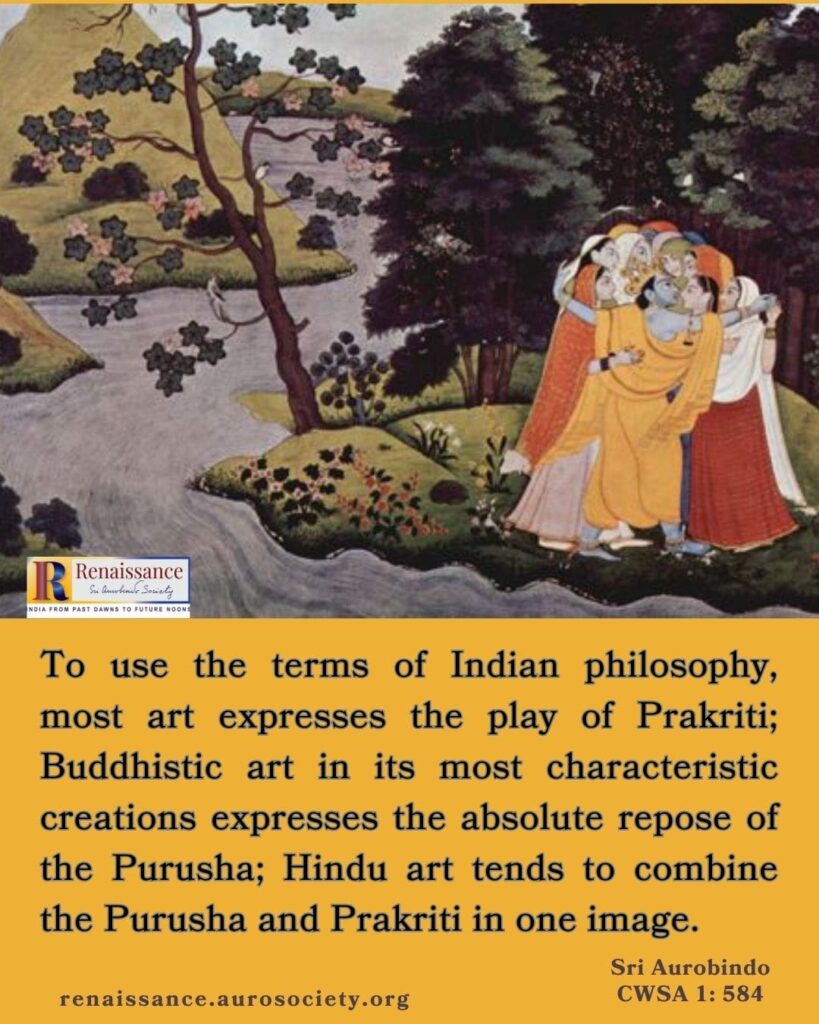
Art and Spiritual Life
Is there any natural opposition between art and the spiritual life? The Puritans had cast aside poetry and music like poison. In the Talmud (the scripture of the Jews) there is the total prohibition to draw the picture of anybody, be he a man or a God. Plato in his Republic refused to award a locus to the poet.
Even in the world of today, behind the externals we are after Idealism that awakens the higher emotions, the spiritual perception, and inspires the spiritual life in poetry, music, painting and sculpture. We want to do away with mundane art and have the art that helps to acquaint us with God. We want to turn our eyes from the art that depicts the lower propensities of our nature. And we like to gaze at the one that gives us a higher, nobler and purer inspiration.
The spiritual knowledge is the supreme knowledge, and the rest is the ordinary knowledge. The spiritual life is alone the best and the only thing worth aspiring for. If this is the only truth then men will aspire for nothing except that which is helpful to the spiritual life. Men will keep aloof from whatever is an obstacle to it.
Every branch of the ordinary knowledge should be made into a step towards the supreme knowledge. If there is any glory or beauty in the world then it belongs to God. So the usefulness of the ordinary knowledge lies in being subservient to the supreme Knowledge. Today we want to found this thesis. But how far is it correct, what is its precise meaning?
At the very outset we would like to say that the object of art is to create joy.
There is one joy in God-realisation, and another in the company of a woman. An artist can make a joyful creation out of either of the two. The depiction of the company of a woman may be harmful to the spiritual life. But from the standpoint of the creation of pure and simple joy, is there any hard and fast rule that its value should be low?
The critic may say:
“God alone is the repository of the complete joy. In the ordinary worldly life there is no lack of joy or beauty. But that joy or beauty is a portion or a shadow of God himself, a major part of it being a deformation. The story of the enjoyment of a woman may be very fascinating. But if we do not find in it anything that may lead our vision to and draw out the sweetness of God then from the side of the creation of taste too it falls short of the perfect perfection.
“If art were to exist in the creation of taste anyhow then the artist might deal with any subject to fulfil his object by any means. But if he wants to create the highest taste, the fullness of taste, let him manifest God in speech, painting and sculpture.”
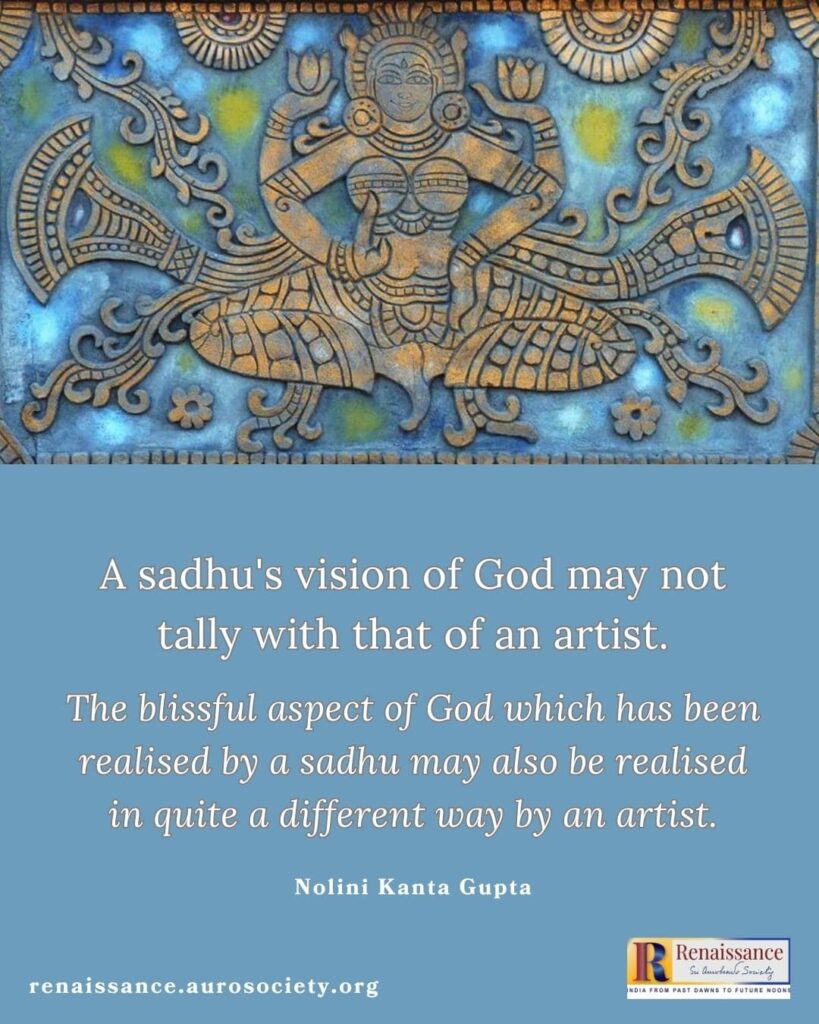
What is God?
But the problem is: What is God, and what again is the blissful form of God? The word God does not mean any fixed, invariable form. God has many a form. There is no end to the ways in which He has been seen by men. So at the very outset we may be in doubt: the God of a sadhu or saint and that of an artist – are they identical or is there any difference between the two? A sadhu’s vision of God may not tally with that of an artist. The blissful aspect of God which has been realised by a sadhu may also be realised in quite a different way by an artist.
In fact, in the eyes of a sadhu, that God alone is holy who is pure, unsullied and who cannot be stained by any earthly impulse. The God of a sadhu shines there alone where there is the complete absence of human impurity, sense-turmoil and grossness. In the eyes of a sadhu he alone is the real artist whose aim is to manifest God who is behind the play of daily transient activities of life and who is All-Good and free from all worldly sin. That artist alone is dear to him who has depicted men as above wants and afflictions and the restlessness of the senses and endowed them with the glow of nobility.
To a sadhu God may possibly be a disciplined, liberated Being. But to an artist He is also the slave of the mind, vital and body.
A sadhu takes delight in renunciation, sanctity. It is the artist who can reveal that the delight of the physical enjoyment or even of the enjoyment which we call impure is no other than and in no way inferior to the delight of God. A sadhu may remain absorbed in tranquil pure bliss, but, if he fails to appreciate the ambrosial bliss which the artist finds in his artistic work in the midst of the surging current of earthly life, then has he not found God piecemeal?
God dwells in the generosity, the nobility of man as well as in the regions beyond the senses. But the same God also dwells in the meanness, narrowness and sensuality of man. The sadhu wants the former. But the artist can portray both the aspects equally in the full manifestation of their truth and beauty.
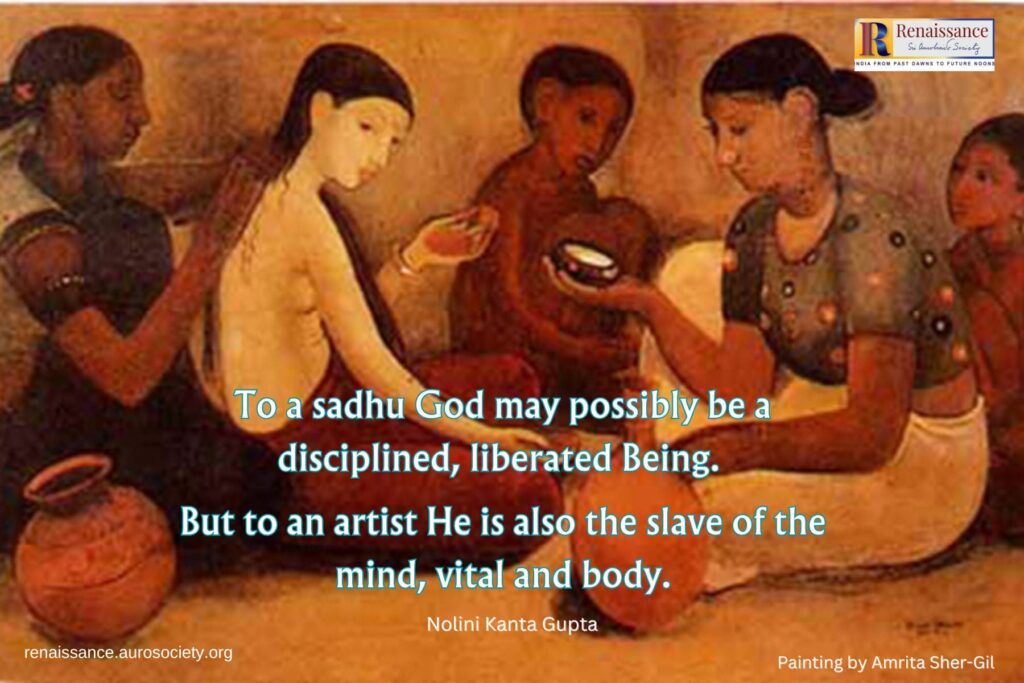
The Aim and Object of a Sadhu and an Artist
The aim and object of a sadhu and those of an artist are not the same. A sadhu and a reformer want to mould men and the world after an ideal. Chastity, truthfulness are such ideals. The demand of a sadhu is that all women for all time should remain chaste and all men remain truthful for ever. That is why he is averse to seeing and showing the picture of an unchaste woman or a man addicted to falsehood. For he fears that such an act may awake unchastity and falsehood in the society. The things that are morally undesirable must be undesirable also in art and in all fields of life.
But the artist argues:
“The things that we do not want to have or to become also harbour God. They too are images of the One who is infinite. They too contain truth. And they too have their special nature and the secret reason of their existence. And I would comprehend them and manifest them before the world’s eyes. I may not like sin, but why should I remain blind to it?
“In actual life I may very well be a pious man, if it be the Will of God to establish virtue in the world through me, but in spite of being a virtuous man why should I refrain from appreciating the play, the object and the ultimate essence of sin?
“Nobody likes to grow old. Eternal youth should be the aim of all. The gods have eternal youth. But, for that reason, are we to say that there is no truth or beauty in old age? Or are we to depict the picture of an old man in such a way that men may have disrespect and hatred for years and feel more attracted to the youthful than to the aged?”
The art of an artist is not meant to set up an ideal however great in the world.
The ideal is ever mutable. A certain ideal may prevail in a certain epoch to attract the heart of the world. The artist’s genius does not follow that ideal. Art is beyond time and space. The artist sees only the eternal truth. He meditates upon the endless mysteries of the divine Nature at play in virtue and vice, in the small and the great, in the present and in the future. He tries to give expression to or manifest that Nature before the eyes of mankind.
The art of an artist may be helpful for the accomplishment of some very useful purpose of the world, because he is able to bring out the real beauty of that purpose. But if he confines himself to this task alone, then human knowledge will remain circumscribed. The world-mystery will remain veiled to a great extent. We shall fail to relish the manifold joy that flows from the diverse beauty of the Divine.
When we sit in judgment to evaluate art we often remain oblivious to these infinite ways of appreciation of joy. At times we want to determine the value of art by the standard of ethical benefit to the pious or by the special form of the Divine imagined by the sadhu. At times we employ art for political or social welfare. A special form for the worship of the Divine may be necessary for practical purposes in different times and climes. The social, the political and the moral progress and welfare are also necessary. But these are not intrinsic to the pure art.
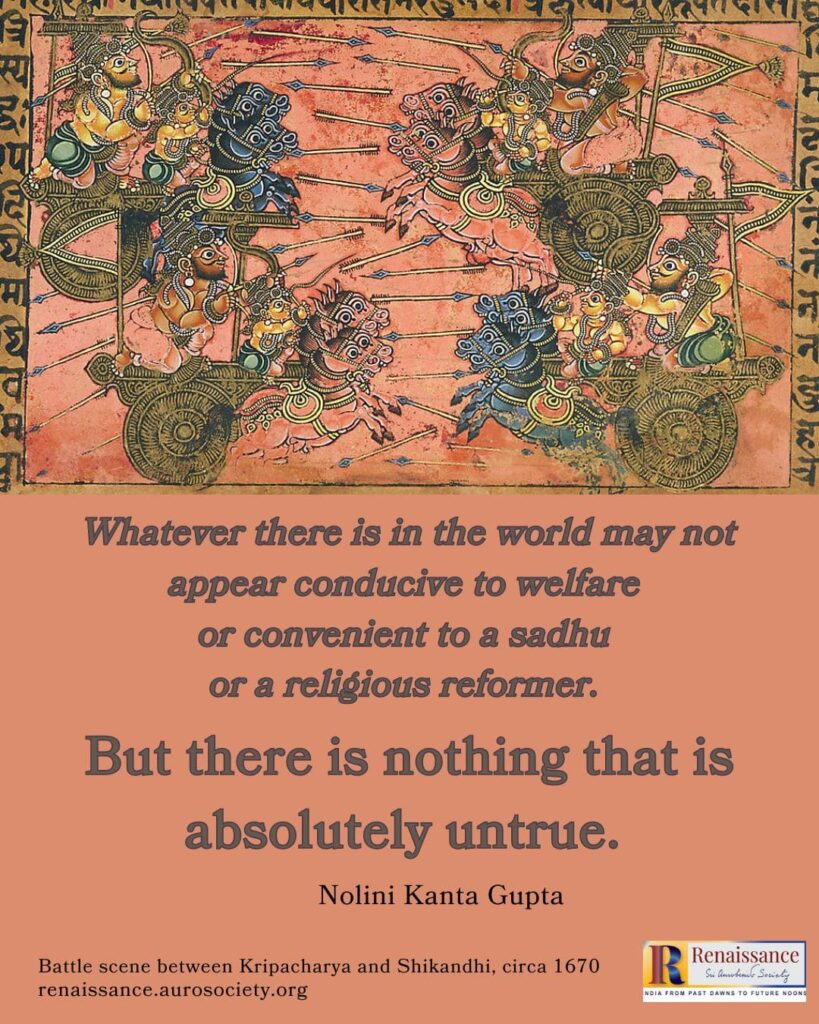
Art for the Expression of the Infinite Truth
We have already said that the fundamental principle of art is the expression of the infinite truth. This truth is vast, all-pervading. There is a hidden truth in everything which may appear beautiful or ugly to the eyes, which may appear attractive or repulsive to our disposition or which may appear good or bad to our intelligence. The truth of a thing consists in its quality, in its uniqueness and speciality and in the part it has to play on the stage of the world. This truth itself is eternal and full of delight. The artist tries to manifest the essence of this truth.
Whatever there is in the world may not appear conducive to welfare or convenient to a sadhu or a religious reformer. But there is nothing that is absolutely untrue. Everything manifests itself through some truth in the core of its being. This truth is the solid delight itself, and therein lies its beauty and this itself is the image of God in it.
The manifestation of this God is the aim of the artist. The ability of the artist that can awaken the spirit of an absolute renunciation is the same as that which can awaken the thirst for action in the man of action. The artist’s prestige does not suffer even when he depicts the madness of lust in a lustful man.
There is no conflict between art and true spirituality.
Rather, spirituality is the life-breath of art and its alpha and omega. Spirituality means things related to the Self. The quintessence of the yogi lies in his yoga and that of a carnal man in his carnality. The artist will reach the acme of his art if he can bring out the quintessence of yoga in the picture of a yogi and the quintessence of carnality in the portrait of the carnal, and godliness in the picture of the gods and beasthood in the likeness of the beast. In this sense the artist alone is the true spiritual man.
An artist may depict Lord Buddha, the Incarnation of compassion, but that is no reason why the atrocious Nadir Shah’s picture should be banished from the domain of art. In the pen of Kalidasa is found the spiritual description of sex-appeal. If this picture proves tendentious to some readers, then, is the fault to be ascribed to Kalidasa the poet? His very purpose was to give expression to this idea. Under certain circumstances this idea may prove an obstacle to spiritual practice, but for that reason who can say that it is fundamentally untrue and ugly?
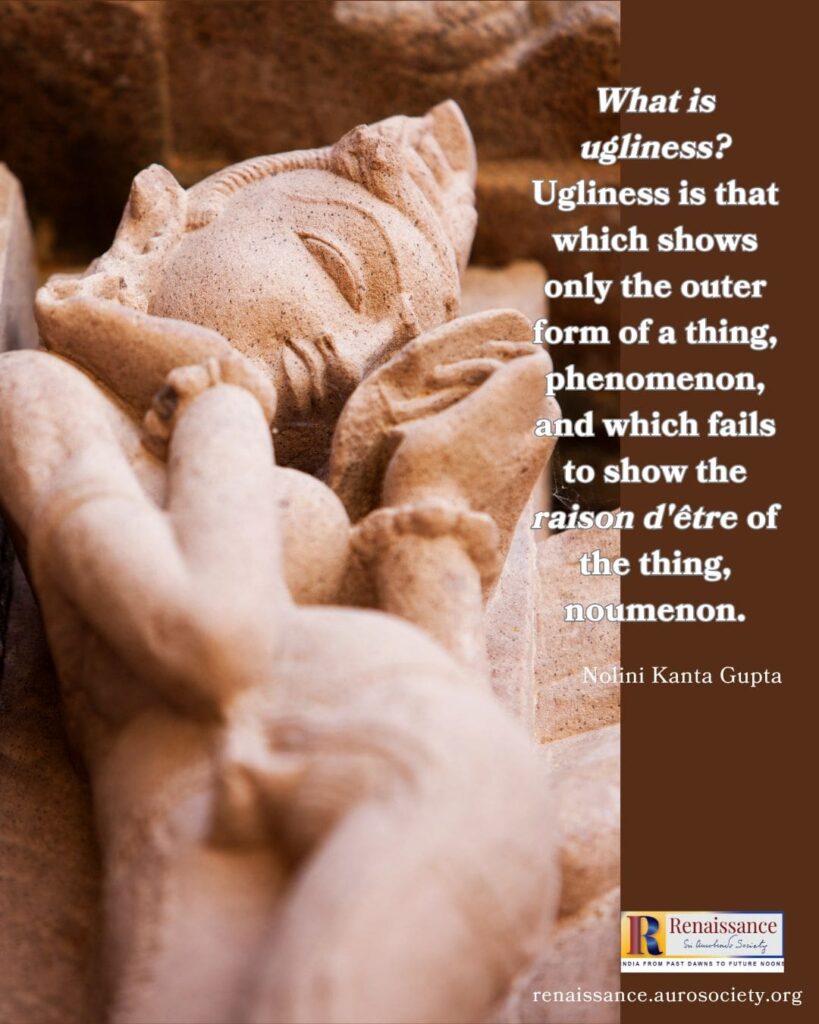
Of Morality and Aesthetic Sense
The picture of a naked woman is offensive to our eyes and not only to our sense of morality but also to our aesthetic sense. For the picture we often see is not verily a work of art but only a photograph, an exact imitation of nature. What is ugliness? Ugliness is that which shows only the outer form of a thing, phenomenon, and which fails to show the raison d’être of the thing, noumenon.
A photograph of anything is often ugly, be it of a naked woman or a saintly man. For we see therein only a naked woman and not the nakedness of a woman. We see therein a sadhu’s lock of hair and the bark for his loins and not his saintliness.
If we judge from an artistic point of view then the pictures of the gods and the goddesses drawn by Ravi Varma are as ugly as the worthless novels of the street. Where there is only body and where we do not get the meaning of the body in some deeper truth behind it, the other-worldliness of the saint is an object of contempt equally to the moralist’s sense of decency and the artist’s aesthetic sense.
Read more by Nolini Kanta Gupta:
The Obscene and the Ugly
The artist who has drawn the picture of a naked woman to express the soul of a naked woman has not seen the naked woman with the naked eyes of a lustful man, nor with those of a sadhu. He has seen her with the eyes of a seer. He has unveiled a divine truth. Other people being duped by the mind say that this is pure, that is impure, this is the virtue, that is vice. But the artist with an insight like that of a seer sees what is the truth, the hidden principle, behind a thing, the perennial source of true delight.
The poet or the seer creates something from the inspiration derived from the truth realised by him. Such an action is above the duality of good and evil, purity and impurity, good will and ill will. For an immature sadhaka, from the standpoint of his sadhana, the absolute realisation of truth by the adept may not always be desirable; still his realisation is an unquestionable truth. The truth meant for the aspirant is momentary, temporary; its value is neither universal nor eternal.
The poet stands on the same footing with the adept. Neither of them should be judged by the standard of discipline applicable to the aspirant. The picture of a naked woman may perturb us. But for that reason why should we refrain from the appreciation of the true beauty revealed therein? Why should we banish the legitimate enjoyment of the senses with a view to controlling them? To deny the presiding deities of the senses for fear of the agitation caused by the senses is itself an obstacle to the realisation of truth.
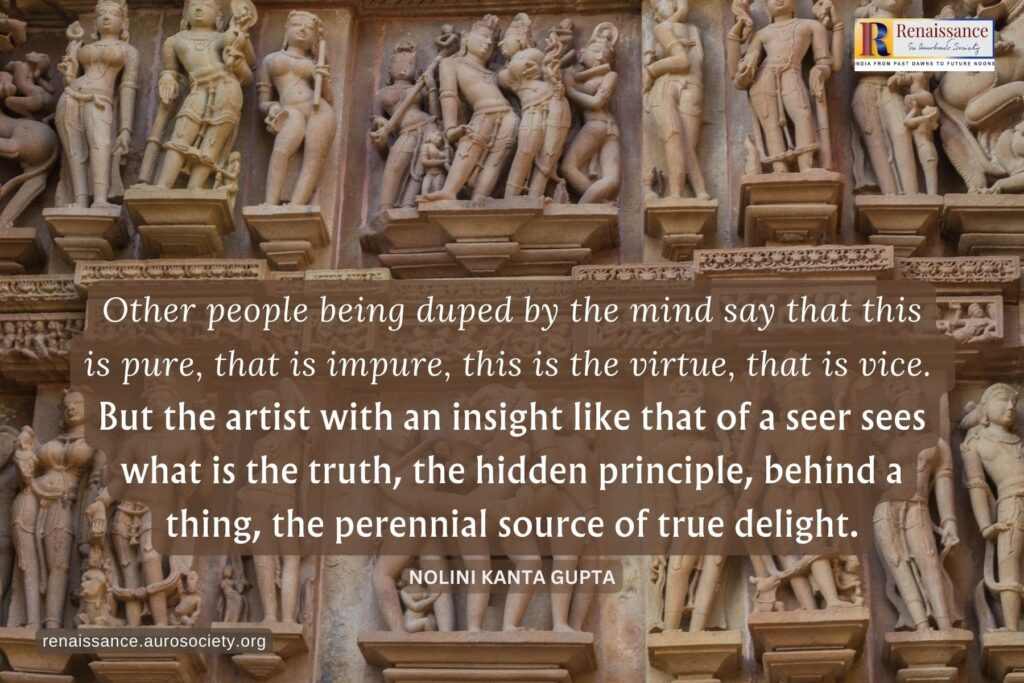
The Different Paths of an Artist and a Sadhu
It is not that art has no value from the standpoint of the spiritual discipline also. But the artist and the sadhu do not tread the same path. The way of the sadhu is “Not this, not this” and that of the artist “Here it is, here it is.”
The sadhu wants to control and get rid of the senses in order to reach the Transcendent or to confine himself within the boundary of a particular way of the use of the senses. The artist wants to feel the Transcendent in the plenitude of wealth of the senses.
The sadhu wants to form a religious life through canon and conduct. The artist does riot subscribe to any hard and fast rule. He considers himself free from the very beginning. If he can hold on to this principle for all time then he can attain to liberation and fulfilment in the entirety of his life.
Read:
The Realisation of Beauty
The sadhu and the pious measure the value of their achievements by the attraction and repulsion they have for the objects of the senses and sit down to analyse their real nature. But the artist pays no attention to discriminating the object he deals with. He knows that essentially there is no flaw in the object. His concern is with his inner attitude. He reveals the true and the beautiful form from whatever he undertakes in his spontaneous urge of the truth within him.
The sadhu wants to have access to spirituality through conduct, example, discipline and interpretations of the scriptures. But the artist wants to attain his goal through the feeling of his art. You may depict the picture of a Madonna or that of a harlot; there is nothing inherent in the subject of your delineation to make you choose the one or the other. The question is whether you have been able to get at the truth of the thing.
Penetrating Influence of Art
Subtle is the penetrating influence of art. We, who live in the physical nature, are unable to feel it readily. We require a massive influence. If it is not clearly pointed out to us we fail to grasp it; we need a baton-charge to be aroused from our slumber. That is why religious scriptures and moral codes have come into existence. We want to introduce moral doctrines in the realm of art as well. Moral doctrines may serve a useful purpose in changing the physical part of our nature. But the subtle inner nature and the spiritual being of man will never be awakened by the canons of morality.
Art is but revelation.
This revelation enables us to hold a direct communion with the innermost truth of our heart. Many a time we become identified with the spirit of things through art. This union is nothing but a union of delight. In religious terminology we may call it divine Grace. One who is endowed with this Grace has no need to observe the rules of conduct or spiritual practice. By the help of this divine Grace the artist can continue his enjoyment of sense-appreciation, yet become flooded with spirituality and get purified without undergoing any hardship or austerity.
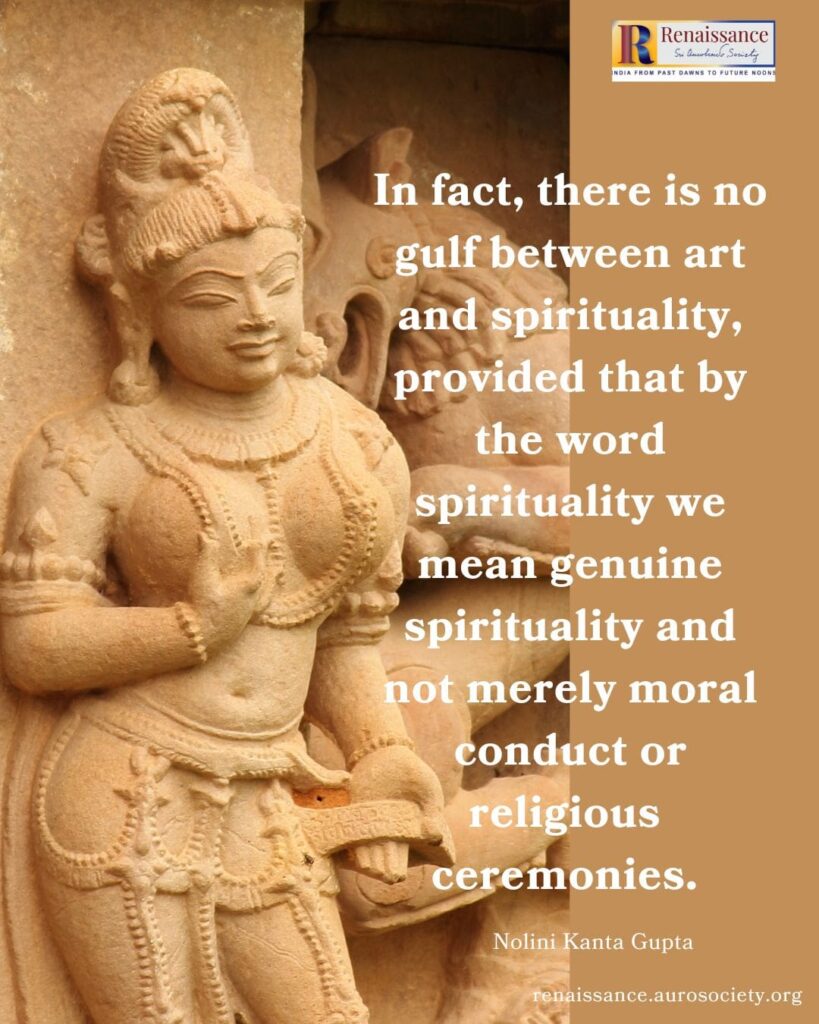
In fact, there is no gulf between art and spirituality, provided that by the word spirituality we mean genuine spirituality and not merely moral conduct or religious ceremonies. If the aim of spirituality is to know the Self, then the aim of art too is the same. If the seer of the spiritual truth can see the Spirit everywhere without excluding the body or any part of it, then why should the artist not be able to manifest the glory of the Spirit through colour, sound, word and stone and thus play the role of a truly spiritual man?

~ Design: Beloo Mehra

